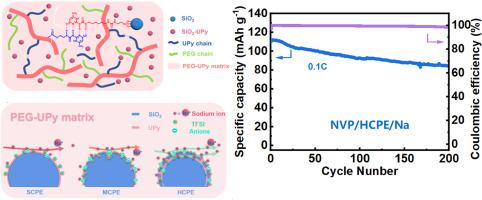Journal of Membrane Science ( IF 8.4 ) Pub Date : 2023-01-30 , DOI: 10.1016/j.memsci.2023.121442
Yongyuan Lin , Xueying Li , Wenlong Zheng , Yongfeng Gang , Lei Liu , Xin Cui , Yuanyuan Dan , Lizhuang Chen , Xiaofang Cheng

|
Batteries matched with flexible intelligent electronic devices are required in the future to supply dense and reliable power security. In addition to energy storage performance, functionalized design of batteries with good mechanical properties and self-healing ability is critical to the development of flexible intelligent electronic devices. The polymer with quadruple hydrogen bonds can give materials the ability to repair mechanical damage and restore the original mechanical properties. The incorporation of inorganic fillers into polymer electrolytes can improve the electrochemical properties and stability of the electrolytes. Optimization of the geometry of inorganic materials could further improve the electrical conductivity of composite electrolytes. In this work, a flexible self-healing polymer electrolyte (Poly (ethylene glycol)-co-ureidopyrimidinone), PEG-UPy) was synthesized. Three different microstructures of SiO2 fillers (solid, mesoporous, and hollow mesoporous) with UPy modified were designed to improve the sodium ion transport performance of the PEG-UPy self-healing polymer electrolyte for sodium ion batteries. The PEG-UPy electrolyte filled with hollow mesoporous SiO2 (PEG-UPy@hSiO2) exhibits an excellent electrochemical performance due to its unique structure among the samples. The PEG-UPy@hSiO2 electrolyte shows the highest ionic conductivity, sodium ion transference number, and appropriate self-healing property. The discharge capacity of NVP/PEG-UPy@hSiO2-NaTFSI (HCPE)/Na cell could reach 110.5 mAh g−1 at 0.1C and the capacity retention rate could reach more than 77.6% after 200 cycles at 60 °C.
中文翻译:

SiO2微观结构对钠金属电池自修复复合电解质离子传输行为的影响
未来需要电池与柔性智能电子设备相匹配,提供密集、可靠的电力保障。除了储能性能,具有良好机械性能和自愈能力的电池的功能化设计对于柔性智能电子设备的发展至关重要。具有四重氢键的聚合物可以赋予材料修复机械损伤和恢复原有机械性能的能力。在聚合物电解质中加入无机填料可以改善电解质的电化学性能和稳定性。优化无机材料的几何结构可以进一步提高复合电解质的导电性。在这项工作中,合成了一种柔性自修复聚合物电解质(聚(乙二醇)-co-ureidopyrimidinone),PEG-UPy)。SiO的三种不同微观结构设计了2种 UPy 改性填料(实心、介孔和空心介孔),以提高用于钠离子电池的 PEG-UPy 自修复聚合物电解质的钠离子传输性能。填充中空介孔SiO 2的PEG-UPy电解质(PEG-UPy@hSiO 2 )由于其在样品中的独特结构表现出优异的电化学性能。PEG-UPy@hSiO 2电解质显示出最高的离子电导率、钠离子迁移数和适当的自修复性能。NVP/PEG-UPy@hSiO 2 -NaTFSI (HCPE)/Na电池在0.1C时的放电容量可达110.5 mAh g −1,在60℃循环200次后容量保持率可达77.6%以上。

































 京公网安备 11010802027423号
京公网安备 11010802027423号